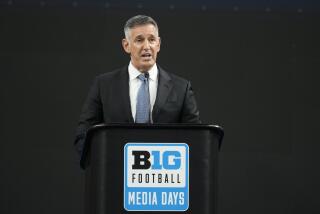Chain Reaction of College Expansion Events Sweeping Nation
Some administrators look at the state of college athletics -- at the deficit spending, the spiraling costs, the rampant uncertainty -- and see chaos.
Jack Lengyel, athletic director at Navy, looks at all of the above and sees a glass that is half-filled with opportunity.
“What better time than now?” Lengyel asked. “When you look around at the possibility for change, it’s a great time, a great opportunity to make effective and important decisions about athletics.
“It will take great leadership. But things are not as bad as (the skeptics) paint it.”
Change is just around the corner for college athletics. As administrators across the country wrestle with grim financial reports, the search for solutions has brought us to the dawning of the age of the super conference, if you believe recent speculation. By the year 2001, you could expect to see the following headlines in college football:
Penn State dumps Nebraska in divisional playoff for Big Ten title
Boston College outlasts South Carolina to win ACC playoff
Notre Dame, Florida State advance to Division I championship game
By the year 2001, you could see five “super conferences” composed of 12 to 16 schools, with each conference negotiating its own network TV contract. You could see a national playoff that would retain, to some degree, the bowl system. You could see the National Collegiate Athletic Association administering its rules and regulations to schools in Divisions II and III only.
Call it the Big Bang. It already has started.
The first cataclysmic blast was heard last December, when Penn State gave up independent status in football to join the Big Ten Conference. The next was heard in February, when Notre Dame bolted from the College Football Association’s five-year television package and negotiated its own TV deal.
Since then, a chain reaction of expansion events has swept across the land. The Southeastern Conference formally invited Florida State, Miami and Arkansas to climb aboard. The once-formidable Southwest Conference, with only two major TV markets, quickly huddled with the Big Eight Conference to talk about consolidation. The Metro Conference wants to add football to its other sports schedules. And the Atlantic Coast Conference, after voting not to expand, had to rethink its stance as the SEC tried to move into its territory.
The subject of all this discussion is economics, particularly as it relates to football. In an attempt to become self-sufficient, athletic departments have had to find new ways of coming up with revenue. The bottom line on college athletic budgets has been written in red.
“It goes back to the perception that intercollegiate programs are fat, and that’s not true,” said Lew Perkins, outgoing athletic director of the University of Maryland. “Michigan lost $2.5 million, Stanford had to cut back 30 track scholarships. The cost of doing business is getting out of hand.”
The problem at Maryland has been even more acute. While trying to bring the budget in line, Perkins’ successor will have to deal with the loss of some $3 million because of recent NCAA basketball sanctions.
The most recent College Football Association financial survey shows that the cost of running a major college program has gone up 34 percent the last four years, while income is up only 21 percent.
Jim Tarman, athletic director at Penn State, played down the financial implications of the move to the Big Ten, yet admitted that it was a hedge against the future.
“I keep reading we did it for money,” Tarman said. “I’m not sure we’ll be further ahead financially. Our feeling was, maybe it’s best for us in the decade ahead, and the next century, to be part of a group that will get into revenue-sharing. Who knows what the future holds? This is a built-in assurance (of solvency).”
All football independents, including Navy, watched the historic Penn State move closely because it could be the start of a trend.
“If everybody goes to a conference, we have to be concerned where we fit,” Lengyel said. “We’ve attempted to talk to all the conferences so we’re aware of what’s happening. We want to be able to make an intelligent decision, not a crisis decision. If the CFA goes down and there’s no consortium for revenues, we might have to look at a conference.”
The health -- and wealth -- of the CFA is another part of the equation. The Federal Trade Commission is investigating antitrust claims against the CFA’s network TV contracts. If the CFA package is ruled in violation of antitrust law, five major conferences (ACC, SEC, SWC, Big Eight, Western Athletic Conference) could be without a national TV deal.
The CFA is heading into the fourth and final year of a $134 million contract with CBS and ESPN. The new contract, with ABC and ESPN, begins in 1991 and is worth $300 million.
The CFA was formed in 1983 when 63 big-time programs decided to break from the NCAA’s TV package. At that point, the Big Ten and Pac-10 started negotiating their own TV deal.
Of the rampant speculation about super conferences, CFA Executive Director Chuck Neinas said, “It’s economically driven. I think television has served as a smoke screen for other economic issues. I think there are some cases where some institutions are trying to get a change in their conference financial structure.”
Ken Haines, executive vice president for Raycom Sports in Charlotte, N.C., is among those who expect a new look for college athletics. The Metro Conference asked Raycom last January to conduct a feasibility study on expansion. The two proposals selected by the league were for a 16-team football conference and a 12-team all-sports conference.
The 16-school super conference would be comprised of the eight Metro schools; Big East schools Syracuse, Pitt and Boston College; Atlantic 10 schools West Virginia, Rutgers and Temple; and independents Miami and East Carolina. Four schools -- Syracuse, Boston College, Pitt and East Carolina -- are not interested in an all-sports conference. Miami, meanwhile, said it is interested only in an all-sports affiliation.
“There is interest in it,” Haines said of the Metro’s super conference plan. “Whether or not some southern schools are able to over come the attractiveness of the ACC or SEC remains to be seen. The super conference makes a lot of sense, looking at the future. You’re talking about TV households that measure between 35 and 40 percent of the country. There are a lot of reasons why it ought to take place. We expect to know in 30 days.”
Not everybody agrees with the concept, though. Bruce Skinner, former executive director for the Fiesta Bowl, does not think the idea will fly once administrators look at it more closely.
If a super conference is formed, somebody’s got to go 1-10,” Skinner said. “And if you have a bunch of (traditional) 10-1 teams, somebody’s got to go 6-5, and that will lessen attendance. For financial reasons, it won’t happen.”
More to Read
Go beyond the scoreboard
Get the latest on L.A.'s teams in the daily Sports Report newsletter.
You may occasionally receive promotional content from the Los Angeles Times.










